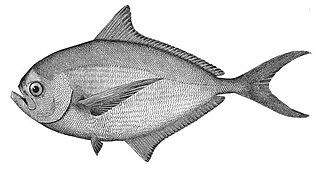
Pomfrets are perciform fish belonging to the family Bramidae. The family currently includes 20 species across seven genera. Several species are important food sources for humans, especially Brama brama in South Asia. The earlier form of the pomfret's name was "pamflet", a word which probably ultimately comes from Portuguese pampo, referring to various fish such as the blue butterfish. The fish meat is white in color.
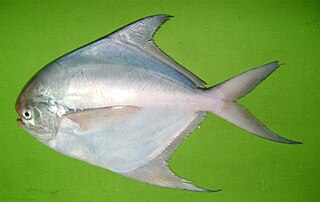
Pampus argenteus, the silver pomfret or white pomfret, is a species of butterfish that lives in the Indo-West Pacific, spanning the coastal waters of the Middle East, Eastern Africa, South Asia, Southeast Asia, and East Asia. The species has been reported only twice, one hundred years apart, from the central Mediterranean Sea.

The Indo-Pacific sergeant is a species of damselfish in the family Pomacentridae. It may also be known as the Sergeant major although this name is usually reserved for the closely related species Abudefduf saxatilis. The closely related Abudefduf caudobimaculatus was formerly considered to be synonymous with this species and, according to some authorities, is synonymous.

The lesser pipefish or Nilsson's pipefish is a pipefish similar to the greater pipefish, but with no crest above the head. Usually it reaches up to 17 centimetres (6.7 in) in length, maximally 18 centimetres (7.1 in), although in South Wales they are usually not more than 10 to 13 centimetres long. They have a light to dark green-brown colour with bar-like markings on the sides.

Pomacanthus maculosus, the yellowbar angelfish, half-moon angelfish, yellow-marked angelfish, yellowband angelfish or yellow-blotched angelfish, is a species of marine ray-finned fish, a marine angelfish belonging to the family Pomacanthidae. It is found in the western Indian Ocean and, more recently, in the eastern Mediterranean Sea.
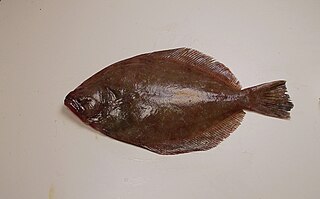
Paralichthys lethostigma, the southern flounder, is a species of large-tooth flounder native to the East Coast of the United States and the northern Gulf of Mexico. It is a popular sport fish and is the largest and most commercially valuable flounder in the western North Atlantic Ocean and Gulf of Mexico. It is a "left-eyed flounder", meaning the left side is pigmented and is the "up side".
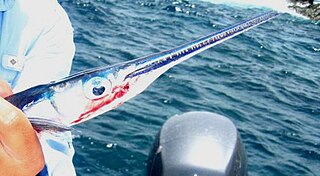
The flat needlefish, or barred longtom, the only known member of the genus Ablennes, is a marine fish of the family Belonidae. Flat needlefish are considered gamefish, frequently caught with the help of artificial lights, but are not often eaten because of their green-colored flesh.

Pagellus bellottii, the red pandora, is a species of marine ray-finned fish belonging to the family Sparidae, the sea breams and porgies. This species is found in the eastern Atlantic Ocean and the Mediterranean Sea.

Brama is a genus of marine ray-finned fishes from the family Bramidae, the pomfrets. Currently, there are 8 species within the genus.
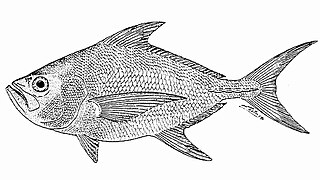
Taractes is a genus of marine ray-finned fishes from the family Bramidae, the pomfrets. Taractes can be distinguished from other bramid genera but having a flat, or slightly curved profile, between the eyes and by having scales on both the dorsal and anal fins.

Holacanthus africanus, the Guinean angelfish or West African angelfish, is species of marine ray-finned fish, a marine angelfish belonging to the family Pomacanthidae. It is found in the warmer sections of the eastern Atlantic Ocean off the coast of West Africa.

Stephanolepis diaspros, commonly known as the reticulated filefish or the reticulated leatherjacket, is a species of bony fish, a ray-finned fish in the family Monacanthidae. Its natural range is the western Indian Ocean but it is also one of the species which has colonised the Mediterranean through the Suez Canal by Lessepsian migration from the Red Sea.

Herklotsichthys punctatus, the spotback herring or spotted herring, is a species of herring from the family Dorosomatidae. It is endemic to the Red Sea and likely entered the Mediterranean Sea via the Suez Canal and is now common on the Levantine Basin.
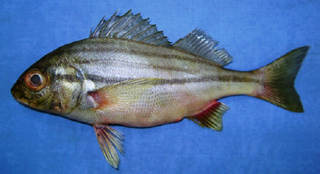
Pomadasys stridens, the striped piggy or lined piggy, is a grunt from the western Indian Ocean and is one of a group of Indo-Pacific marine species which have colonised the Mediterranean Sea through the Suez Canal from the Red Sea, a process known as Lessepsian migration.
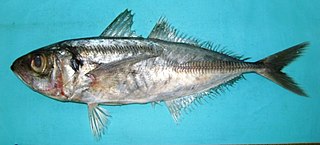
The Arabian scad is a species of jack mackerel from the family Carangidae which is found in the Western Indian Ocean.

Brama japonica, the Pacific pomfret, is a species of marine ray-finned fish, a pomfret of the family Bramidae. B. japonica is closely related, and quite similar, to Brama brama, but can be distinguished by possessing a greater number of anal fin rays and a higher number of gill rakers.
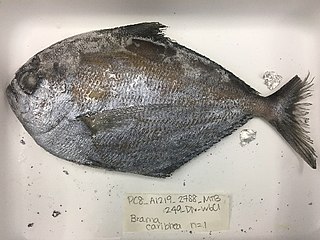
Brama caribbea, the Caribbean pomfret, is a species of marine ray-finned fish, a pomfret of the family Bramidae. It is found in the Western Atlantic Ocean.

Brama dussumieri, the lesser bream or lowfin pomfret, is a species of marine ray-finned fish, a pomfret of the family Bramidae. It is found in warm seas around the world.

Priacanthus arenatus, the toro or Atlantic bigeye, is a species of marine ray finned fish, a bigeye in the family Priacanthidae. Some anglers refer to this fish as "toro snapper", but it is not a snapper, and only distantly related to the fish of the snapper family. It is found across much of the Atlantic Ocean.
Epinephelus geoffroyi, the Red Sea spotted grouper, is a species of marine fish in the genus Epinephelus in the grouper family. The species was first described in 1870. E. geoffroyi was previously considered a synonym of Epinephelus chlorostigma, but Randall et al. recognized it as a valid species in 2013.


















